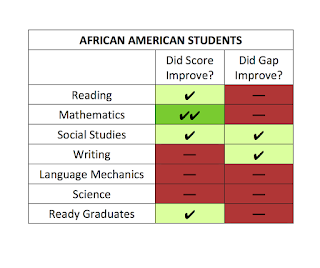| Susan Perkins Weston |
Kentucky is building a new accountability system. The federal Every Student Succeeds Act (ESSA) gives us more options than No Child Left Behind offered, and that’s one reason for the change. The bigger reason for change is to identify where we want to take our own children, how we’ll check and report our progress, and how we’ll respond if that progress gets off track. Six questions look to me like the minimum topics Kentucky must address in a new system. Here, I’ll explain those questions and share a few notes on each.
1. What should our rising generation know and be able to do?
Kentucky law sets our overarching goals, and the Kentucky Academic Standards add detail, including expectations for each grade or level.
ESSA requires Kentucky to set “challenging State academic standards” that are “aligned with entrance requirements for credit-bearing coursework in the system of public higher education [and] State career and technical education standards.” Keeping current standards, modifying them, or starting over will all be options.
So far, I haven’t heard much talk of major standards changes, but there is discussion of reviewing math and language arts after six years of use, and social studies may also be ready for some fresh thought.
2. What indicators can we use to track our progress toward those desired results?
Our current accountability rules use assessment data to indicate how students perform each year in six subjects and their year-to-year growth in reading and math. They also consider graduation rates and program reviews.
Under ESSA, Kentucky needs five kinds of indicators:
- Achievement, shown by proficiency on assessments
- Growth or another “statewide academic indicator”
- Graduation rates
- English language proficiency for English learners.
- At least one additional indicator of “school quality or student success.”
English language proficiency does not have to be broken out (disaggregated) by student groups, but disaggregation is required for all the other indicators we use.
Kentucky is completing a major discussion of elements to include in a school’s “dashboard “ of data. Next steps may include specifying which assessments Kentucky will use and whether Kentucky will choose the growth or the “other academic” option. There is interest in using attendance or chronic absences as a “school quality or student success” measure, and other data may also be included there.
3. How far and how fast do we intend to raise those indicators?
In years past, Kentucky aimed for proficiency in seven subjects by 2012 (and later by 2014). Our current system asks schools to move Next Generation Learner scores up half a point or a point a year—setting a somewhat slower improvement pace.
ESSA calls for “ambitious State-designed long-term goals, which shall include measurements of interim progress.” ESSA also calls for subgroup goals calling for underserved groups to “make significant progress in closing statewide proficiency and graduation rate gaps.”
At the Prichard Committee’s Annual Meeting, Kati Haycock of the Education Trust urged the participants to pay close attention to these choices. The long-term goals and interim measurements are where Kentucky can show our sense of urgency about our students’ futures.
4. How will we differentiate schools each year?
Our indicators will be used to report annually on how each school is doing. Recently, Kentucky has differentiated schools by calling them distinguished, proficient, or needs improvement. Our next system could use those terms, other words, letter grades, or another approach. A system of star ratings appears to be the leading idea.
ESSA also says the process must “include differentiation of any such school in which any subgroup of students is consistently underperforming.” The term “underperforming” seems to include all gaps rather than just the larger ones. Deciding how the differentiation method can make those student group issues highly visible will be an important challenge
5. How will we identify schools for added support?
Kentucky’s currently identifies priority schools and focus schools. ESSA lets us move to identifying schools for:
- Targeted support and improvement if they have the underperforming subgroups mentioned in the differentiation discussion.
- Additional targeted support if a student subgroup performs like the bottom 5% of schools.
- Comprehensive support and improvement if they are in the bottom 5% of schools or if one-third of students don’t graduate (high school only) or if schools are in additional targeted support for too many years (with the state defining too many).
Can Kentucky identify the bottom 5% of schools (and groups scoring like the bottom 5%) without combining all indicators in a single number? So far I have not seen a mathematical way to do that, but one good demonstration could quickly convince me.
6. What support will we provide to identified schools?
How can we change results at schools that have not moved students forward in the ways the state calls for? Kentucky has tried consequences, and we’ve tried intervention, and ESSA calls for Kentucky to identify its own best plan for support and improvement work.
For this challenge, I hope Kentucky can choose a short list of key elements a school should work on, allowing the folks at the school do deep, sustained work on that short list.
Source note: The ESSA requirements listed here are set in Section 1111 of the new federal legislation.





